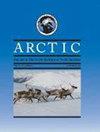曼尼托巴省北部灰熊(Kakenokuskwe osow Muskwa(克里语),Ursus arctos)的知识状况
IF 0.8
4区 地球科学
Q4 ENVIRONMENTAL SCIENCES
引用次数: 1
摘要
在过去的四十年里(1980-2020年),在加拿大马尼托巴省北部观察到灰熊的频率越来越高,它们可能起源于努纳武特和西北地区的既定种群。我们总结并呈现了对马尼托巴省北部灰熊的跨学科综合观察,这些观察来自哈德逊湾公司档案馆的历史记录、已发表的文献、直接观察、远程相机观察、政府机构报告、第一作者的实地笔记、自愿观察以及媒体和社交媒体报道。总共记录了160次观测,其中140次是1980年以来的观测。从空间上看,这些观测结果都位于曼尼托巴省的北极南部、哈德逊平原和泰加地盾生态区内,从努纳武特边界的曼尼托巴北部边界到纳尔逊河南岸。1980年之前,灰熊在马尼托巴省北部历史上存在,尽管数量非常少,但自那时以来,观测频率显著增加。大多数观测(86%)距离哈德逊湾海岸不到1公里。灰熊似乎选择了开放的栖息地,而不是森林栖息地。然而,报告的观测在很大程度上是机会主义的,而且观测工作的地理分布不均衡,因此我们的数据可能包含空间和时间偏差。所有已证实的观测结果都是单熊,这表明目前的种群很可能是通过从种群向北扩散来维持的。了解丘吉尔北部和西部的灰熊生态、分布和人口统计,对于更准确地评估该省灰熊的状况和保护需求至关重要。本文章由计算机程序翻译,如有差异,请以英文原文为准。
The State of Knowledge about Grizzly Bears (Kakenokuskwe osow Muskwa (Cree), Ursus arctos) in Northern Manitoba
Grizzly bears have been observed with increasing frequency in northern Manitoba, Canada over the last four decades (1980 – 2020), likely originating from the established population in Nunavut and the Northwest Territories. We summarize and present an interdisciplinary synthesis of documented observations of grizzly bears in northern Manitoba from historical records from the Hudson’s Bay Company Archives, published literature, direct observations, remote camera observations, government agency reports, the first author’s field notes, volunteered observations, and media and social media reports. A total of 160 observations were recorded, 140 of them since 1980. Spatially, these observations all fall within the Southern Arctic, Hudson Plains, and Taiga Shield ecozones within Manitoba and span from the northern limit of Manitoba at the Nunavut border to the south shore of the Nelson River. Grizzly bears were historically present in northern Manitoba prior to 1980, though in very low numbers, but the frequency of observations has increased significantly since then. Most observations (86%) were less than 1 km from the Hudson Bay coast. Grizzly bears appear to select for open habitats and against forested ones. Reported observations, however, have been largely opportunistic, and the geographical distribution of observer efforts was uneven, so our data likely contain spatial and temporal biases. All confirmed observations were of single bears, suggesting that the present population is likely maintained by dispersal from the population to the north. Understanding grizzly bear ecology, distribution, and demographics north and west of Churchill will be critical for more accurately assessing the status and conservation needs of grizzly bears in the province.
求助全文
通过发布文献求助,成功后即可免费获取论文全文。
去求助
来源期刊

Arctic
地学-环境科学
CiteScore
2.30
自引率
0.00%
发文量
51
审稿时长
6-12 weeks
期刊介绍:
Arctic is a peer-reviewed, primary research journal that publishes the results of scientific research
from all areas of Arctic scholarship. Original scholarly papers in the physical, social, and biological
sciences, humanities, engineering, and technology are included, as are book reviews,
commentaries, letters to the editor, and profiles of significant people, places, or events of northern
interest
 求助内容:
求助内容: 应助结果提醒方式:
应助结果提醒方式:


